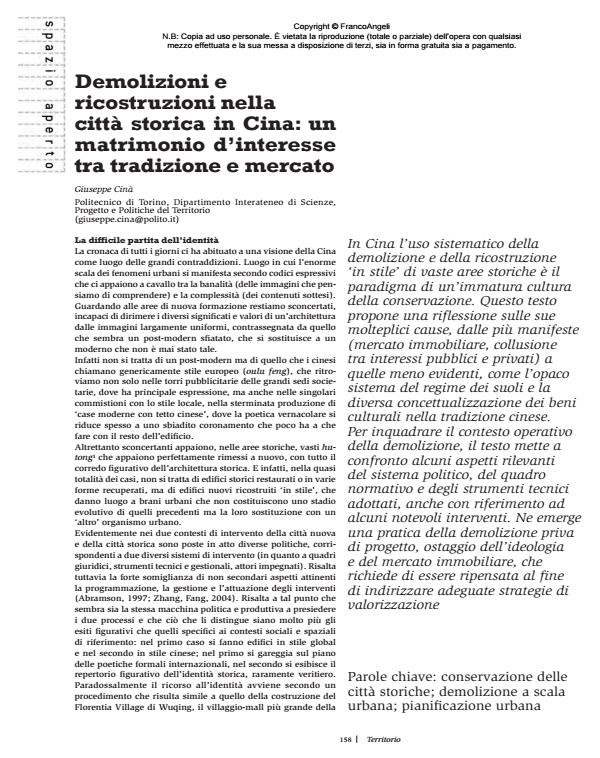Demolizioni e ricostruzioni nella città storica in Cina: un matrimonio d’interesse tra tradizione e mercato
Titolo Rivista TERRITORIO
Autori/Curatori Giuseppe Cinà
Anno di pubblicazione 2015 Fascicolo 2015/72
Lingua Italiano Numero pagine 9 P. 158-166 Dimensione file 397 KB
DOI 10.3280/TR2015-072023
Il DOI è il codice a barre della proprietà intellettuale: per saperne di più
clicca qui
Qui sotto puoi vedere in anteprima la prima pagina di questo articolo.
Se questo articolo ti interessa, lo puoi acquistare (e scaricare in formato pdf) seguendo le facili indicazioni per acquistare il download credit. Acquista Download Credits per scaricare questo Articolo in formato PDF

FrancoAngeli è membro della Publishers International Linking Association, Inc (PILA)associazione indipendente e non profit per facilitare (attraverso i servizi tecnologici implementati da CrossRef.org) l’accesso degli studiosi ai contenuti digitali nelle pubblicazioni professionali e scientifiche
In Cina l’uso sistematico della demolizione e della ricostruzione ‘in stile’ di vaste aree storiche è il paradigma di un’immatura cultura della conservazione. Questo testo propone una riflessione sulle sue molteplici cause, dalle più manifeste (mercato immobiliare, collusione tra interessi pubblici e privati) a quelle meno evidenti, come l’opaco sistema del regime dei suoli e la diversa concettualizzazione dei beni culturali nella tradizione cinese. Per inquadrare il contesto operativo della demolizione, il testo mette a confronto alcuni aspetti rilevanti del sistema politico, del quadro normativo e degli strumenti tecnici adottati, anche con riferimento ad alcuni notevoli interventi. Ne emerge una pratica della demolizione priva di progetto, ostaggio dell’ideologia e del mercato immobiliare, che richiede di essere ripensata al fine di indirizzare adeguate strategie di valorizzazione
Parole chiave:Conservazione delle città storiche; demolizione a scala urbana; pianificazione urbana
- Rural Built Heritage Preservation and Development in Chinese Ethnic Areas Qi Mu, pp.35 (ISBN:978-3-031-82531-6)
Giuseppe Cinà, Demolizioni e ricostruzioni nella città storica in Cina: un matrimonio d’interesse tra tradizione e mercato in "TERRITORIO" 72/2015, pp 158-166, DOI: 10.3280/TR2015-072023